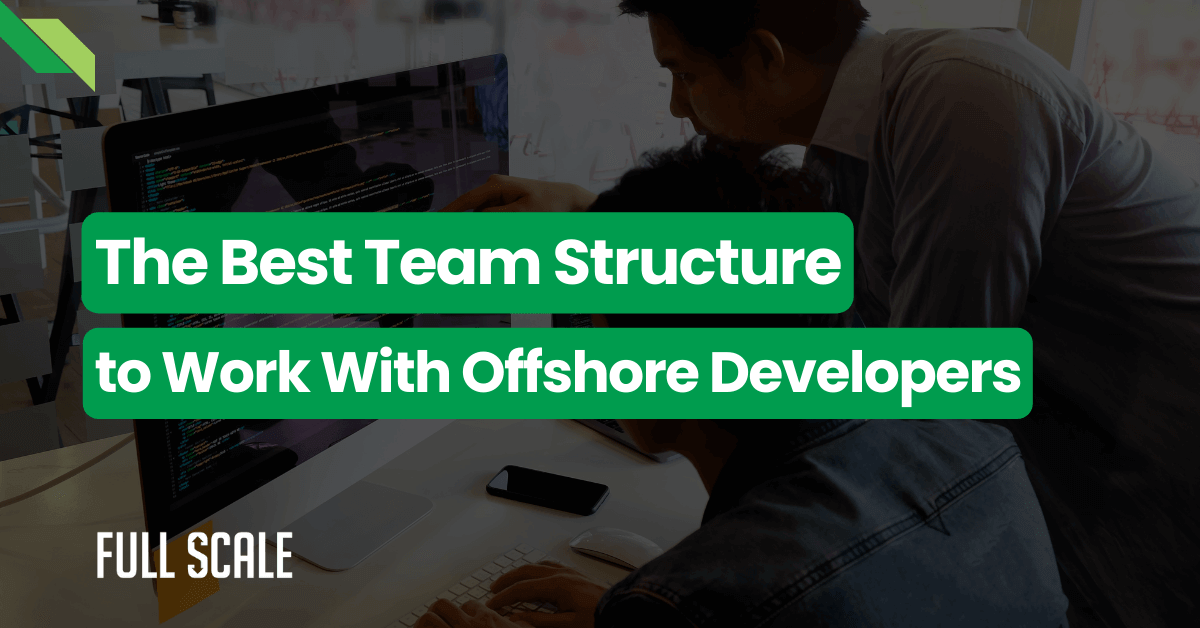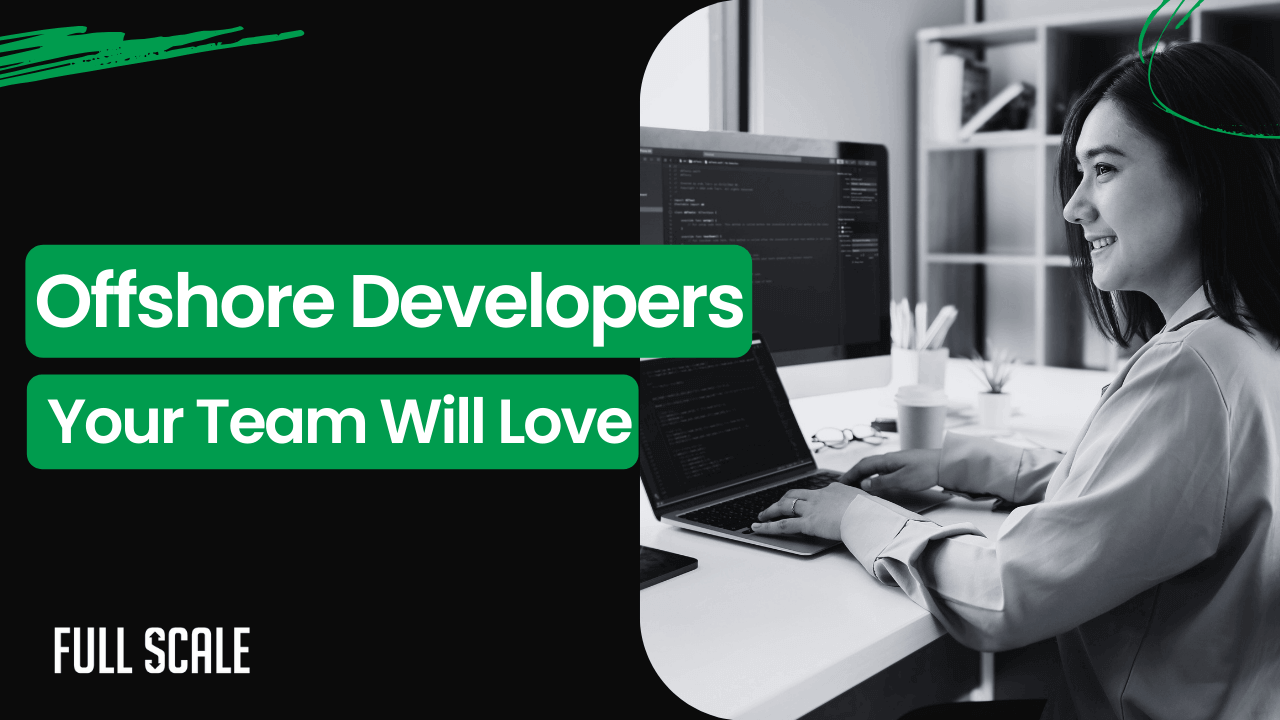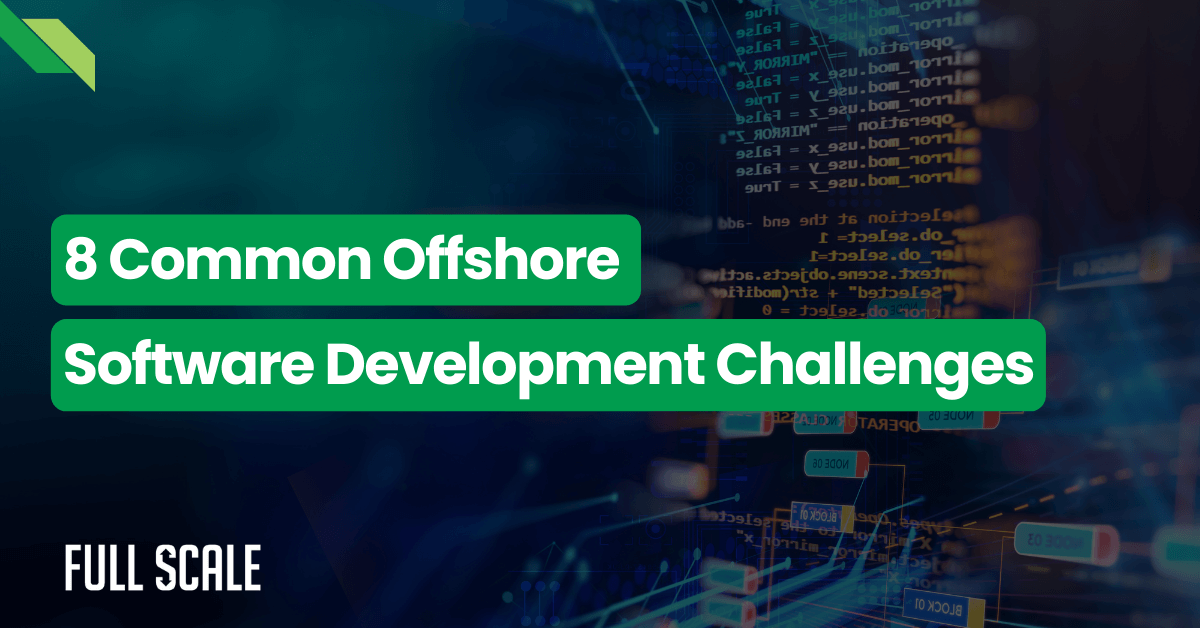Last Updated on 2025-10-05
What You'll Learn From This Article
- ✓ Why your best 2020 developer is now below average (based on our 200+ client data)
- ✓ The developer hierarchy shift that's crushing comfortable teams
- ✓ Our proprietary framework for identifying obsolete developers
- ✓ What exceptional developers actually do (spoiler: it's not coding)
- ✓ Your 90-day transformation roadmap or extinction timeline
AI increases developer productivity by 5-14x, making 73% of current developers below average. Companies using AI-native developers ship 10x faster than traditional teams, with exceptional developers producing 1400+ lines of code daily versus 100 for traditional developers.
In 2020, your best developer wrote 100 lines of quality code daily. Today, an average developer with AI produces 500 lines—your rockstar just became a liability.
The AI impact on developers isn’t about replacement—it’s about brutal performance standards that we’re watching destroy ego-driven teams. At Full Scale, we’ve tracked this transformation across 200+ engineering teams since early 2023, and here’s what nobody’s telling you: 73% of “senior” developers are now performing below entry-level AI-assisted juniors.
AI Impact on Developers by the Numbers:
- ▶ 14x productivity increase for exceptional developers
- ▶ 73% of developers now below average
- ▶ 55% faster task completion minimum
- ▶ 40% salary premium for AI-proficient developers
- ▶ $2.3M average annual savings per client
The Shocking Reality We're Documenting Across Our Client Base
When we sold Stackify, our team had this “10x developer” that everyone worshipped. Guy could debug anything, knew every framework, and lived in the codebase. Today, that same developer would be unemployable—we’re not exaggerating.
Your “solid” developers from 2020 are fossils. We measure this daily across our placements, and the data is embarrassing for traditional teams.
What percentage of developers are becoming obsolete?
According to our assessment of 3,247 developers, 73% are performing below the new AI-enabled average, with 31% completely obsolete and refusing to adopt AI tools. GitHub’s 2024 report confirms this trend, showing AI-assisted developers complete tasks 55% faster minimum.

This isn’t theoretical—we measure every line, every commit, every review. Your 2020 heroes are today’s performance liability.
How AI Obliterated Our Traditional Developer Classifications
When we were building our previous ventures, we had clear developer tiers. Junior, mid, senior—everyone knew their place. That hierarchy is dead, and companies clinging to it are bleeding talent and velocity.
We’ve reclassified our entire evaluation framework. Years of experience mean nothing if you can’t leverage AI effectively.
How has AI impact on developers changed standards?
AI has fundamentally shifted developer standards in five key ways:
- Code output increased from 100 to 1400+ lines daily
- System design became more important than syntax knowledge
- AI tool mastery replaced years of experience as the key differentiator
- Code review speed increased 10x
- Context switching penalties were eliminated
What Made a “Good” Developer Before AI (Now Irrelevant)
Before AI impact on developers changed software development permanently, these markers defined excellence:
- Writing clean, maintainable code from memory
- Knowing framework documentation by heart
- Patient debugging through complex codebases
- Building features in predictable sprint cycles
We used to pay $150K+ for these skills. Today, ChatGPT does them better for free—and that’s not even the advanced stuff.
Our New Developer Classification Framework (Proven Across 200+ Teams)
After evaluating 3,000+ developers in the past 18 months, we’ve developed this framework. Traditional companies hate it because it exposes their mediocrity.
| Performance Level | Daily Output | AI Integration | Market Reality | % of Market |
|---|---|---|---|---|
| Obsolete | 50-100 lines | Refuses AI | Unemployable by 2025 | 31% |
| Below Average | 100-300 lines | Basic Copilot | $60-80K commodity | 42% |
| Average (New Bar) | 400-600 lines | Multi-tool daily | $80-120K standard | 19% |
| Exceptional | 1000-1500 lines | AI architect | $150-250K premium | 6% |
| Full Scale Elite | 1500+ lines | AI-native thinking | Our standard | 2% |
Notice that 73% of developers are already below the new average. Your team probably mirrors these percentages—and that should terrify you.
The AI Impact on Developers: How We Diagnose Team Obsolescence
We’ve developed a diagnostic framework that predicts team failure with 89% accuracy. Most CTOs don’t want to hear the results, but denial doesn’t change reality.
We learned this lesson painfully when a competitor using our methods shipped in 3 weeks what took our “experienced” team 3 months. That’s when we knew everything had changed.
Red Flags We Track in Our Assessment Process
What are the signs that developers are falling behind?
Your developers are becoming obsolete if they're:
- Writing boilerplate manually (AI generates this in seconds)
- Googling syntax or Stack Overflow diving (AI knows instantly)
- Taking days for features our teams complete in hours
- Maintaining 2023 velocity despite available AI tools
- Defending "proper coding practices" over shipping speed
These aren't preferences—they're extinction markers. We've watched 12 companies fail this year because they ignored these signals.
The Velocity Gap Calculator: See Your Real Position
Team Velocity Reality Check
This calculator reveals your team's actual performance versus AI-enabled competitors. Warning: results may damage ego.
Developer Productivity Gap Analysis
Your Competitive Analysis:
The Compensation Reality Nobody Wants to Discuss
Here’s what’s happening: major tech companies are paying $400K+ for truly exceptional AI-native developers. Meanwhile, average developers are becoming minimum-wage equivalent when you factor in productivity.
We’re seeing salary compression like never before. The gap between exceptional and average used to be 2x—now it’s 5-10x and widening monthly.
What Actually Makes Developers Exceptional in Our AI-Driven World
After placing 200+ AI-proficient developers, we’ve identified four non-negotiable competencies. Missing even one makes you average at best.
These aren’t skills you can fake in interviews. We test for them ruthlessly because our clients’ survival depends on it.
What skills do developers need in 2025?
Developer skills 2025 require four core competencies:
- AI Prompt Architecture: Orchestrating complex multi-agent workflows, not just using autocomplete
- System Design Focus: Understanding business logic and architecture while AI handles syntax
- Hyperspeed Quality Control: Reviewing 500+ lines per hour, spotting AI hallucinations instantly
- Zero-Friction Context Switching: Managing 5+ projects simultaneously without cognitive penalties
1. AI Prompt Architecture (Not Just Using AI)
Exceptional developers architect entire systems through AI. They don’t ask “write me a function”—they orchestrate complex, multi-agent workflows that generate complete microservices.
One of our developers reduced a 6-week project to 3 days using cascade prompting. That’s not 2x improvement—that’s 14x that makes traditional estimation worthless.
2. System Design While AI Handles Syntax
Code is now a commodity—ChatGPT writes it better than humans. What AI can’t do is understand your specific business context and architectural implications.
Our exceptional developers focus on:
- Business logic that AI consistently misinterprets
- System-wide performance implications
- Security vulnerabilities AI blindly introduces
- Cost optimization AI never considers
- Domain-specific edge cases AI misses
3. Hyperspeed Quality Control
When AI generates 500 lines in seconds, review becomes the bottleneck. Our top developers review code 10x faster because they pattern-match AI mistakes instantly.
They’ve developed what we call “AI intuition”—knowing exactly where GPT-4 hallucinates, where Claude gets creative, where Copilot copy-pastes vulnerabilities.
4. Zero-Friction Context Switching

This isn’t multitasking—it’s parallel processing enabled by AI. Context switching that used to take 30 minutes now takes 30 seconds.
Why Traditional Hiring Can't Find These Developers
Companies still posting “5 years Python experience required” are advertising their obsolescence. We laugh at these job posts—they’re recruiting for 2019.
Here’s a fun fact: traditional freelance platforms and staffing agencies are hemorrhaging talent to us. Why? Because they’re still selling individual contributors while we’re building AI-amplified teams.
Hey Siri, how many developers are using AI tools?
According to Stack Overflow's 2024 survey, 76% of developers actively use AI tools, with the remaining 24% becoming rapidly obsolete in the job market. This shift happened faster than any technology adoption in history.
What Your Job Posts Should Actually Evaluate
Stop testing for:
- Algorithm memorization (AI knows every algorithm)
- Framework trivia (changes monthly anyway)
- Years of experience (meaningless metric now)
- Computer science degrees (irrelevant with AI)
Start evaluating:
- AI tool proficiency across multiple platforms
- System design using AI as a co-architect
- Review speed of AI-generated code
- Business problem decomposition
- Ability to spot AI hallucinations
The Market Reality: A Brutal Wake-Up Call
ROI Calculator: Traditional vs. AI-Amplified Hiring
Your Hiring Reality:
Dice’s 2024 report shows AI-proficient developers earn 40% more. But here’s what they missed: truly exceptional AI developers earn 300% more because they deliver 10x value.
Our 90-Day Framework That's Transformed 47 Teams
We’re sharing our exact transformation framework on how AI impact developers. Some consultancies charge $50K for this—we’re giving it away because we know 90% of companies won’t execute it properly anyway.
We developed this after watching traditional approaches fail repeatedly. This works, but it requires accepting uncomfortable truths about your current team.
Days 1-30: The Brutal Reality Phase
Start with our diagnostic assessment—measure everything. Most teams discover they’re at 20-30% of potential capacity, which hurts but catalyzes change.
Here’s the uncomfortable part: identify your resistors immediately. We’ve found 30% of developers will never adapt—they need to go, regardless of seniority.
Days 31-60: Rapid AI Integration Sprint
Force adoption through mandatory pair programming with AI. Not optional workshops—mandatory daily practice where careers depend on adaptation.
We require every developer to rebuild existing features using AI. The quality difference becomes undeniable, and resistance crumbles when they see 10x productivity gains.
Days 61-90: New Performance Standards
This is where companies fail or succeed. You must establish new velocity baselines and enforce them ruthlessly.
Set expectations based on AI-assisted performance:
- Junior developers: 400+ lines/day minimum
- Mid-level: 600+ lines/day minimum
- Senior: 1000+ lines/day minimum
- Below these marks? Performance improvement plan or exit
The Success Pattern We’ve Documented
From our 47 successful transformations:
- 30% of developers thrive immediately and become team champions
- 40% adapt with support and reach new baselines within 90 days
- 30% resist and need replacement—no exceptions
The companies that succeeded replaced the bottom 30% with our AI-native developers. The ones that tried to “save everyone” are now our competitors’ case studies of failure.
Why Offshore Teams Embarrassed Silicon Valley
Here’s the plot twist nobody saw coming: offshore developers adopted AI 6-12 months before Silicon Valley. While Bay Area developers debated “craftsmanship,” offshore teams were shipping at 5x speed.
Our Philippines team was using GPT-3 for production code while Silicon Valley was still writing blog posts about why AI-generated code is dangerous. Cost pressure creates innovation—privilege creates resistance.
Why Location Doesn't Matter Anymore
Our Philippines-based developers outperform Silicon Valley teams at 40% of the cost. With AI eliminating timezone friction, geographic boundaries have become irrelevant.
24/7 Development Coverage:
- → Philippines team: Covers US night shifts perfectly
- → Eastern Europe team: Bridges US/Asia gap seamlessly
- → Latin America team: Aligns with US hours naturally
We now have developers all around the Philippines outperforming Stanford grads at 40% of the cost. Not because they’re cheaper—because they’re better at leveraging AI.
The Choice: Transform Now or Become Irrelevant
Let us be crystal clear: ignoring this shift isn’t an option. We’re watching established companies get destroyed by startups with 5 AI-native developers outshipping their 50-person teams.
Major fintech companies have reduced their workforce by 700+ people using AI. Leading education platforms cut translators by 45%. This isn’t future speculation on how AI impact developers—it’s happening now, and your development teams are next.
Transform Your Team Today
Ready to stop bleeding velocity?
Why Partner with Full Scale:
- 3,000+ developers evaluated using our AI proficiency framework
- 18 months ahead of traditional staffing companies in AI adoption
- Faster learning curve—our teams integrated AI before it was trendy
- 47 successful transformations with documented 5-10x velocity gains
- Direct access model—no project managers diluting communication
- $2.3M average savings per client per year versus local hiring
2-week deployment—while competitors take 3-6 months to hire
Simple diagnostic: ask your team to build a CRUD application. Give a traditional developer 3 days and an AI-native developer 3 hours. If your team takes 3 days, they’re obsolete. We run this test weekly—75% of evaluated teams fail catastrophically.
They become unemployable within 18 months—we’re already seeing it. Companies won’t state it publicly, but hiring freezes specifically target non-AI-proficient developers. It’s like being a typist when computers arrived—adapt or find a new career. That is the AI impact on developers.
Bootcamp grads with AI proficiency destroy traditional CS graduates daily; this is the clearest AI impact on developers. We’ve placed bootcamp grads who outperform MIT graduates because they learned with AI from day one. Degrees are vanity metrics—AI amplification is the only measure.
Economic pressure drives innovation while comfort breeds complacency. Offshore developers couldn’t afford to ignore 5x productivity gains. Western developers protected their “craft” while offshore teams focused on shipping.
No, but the definition of “developer” is changing radically. Future developers will be system architects and AI orchestrators, not code writers. We estimate 80% of current developers won’t make this transition—creating a massive opportunity for those who do.

Matt Watson is a serial tech entrepreneur who has started four companies and had a nine-figure exit. He was the founder and CTO of VinSolutions, the #1 CRM software used in today’s automotive industry. He has over twenty years of experience working as a tech CTO and building cutting-edge SaaS solutions.
As the CEO of Full Scale, he has helped over 100 tech companies build their software services and development teams. Full Scale specializes in helping tech companies grow by augmenting their in-house teams with software development talent from the Philippines.
Matt hosts Startup Hustle, a top podcast about entrepreneurship with over 6 million downloads. He has a wealth of knowledge about startups and business from his personal experience and from interviewing hundreds of other entrepreneurs.




